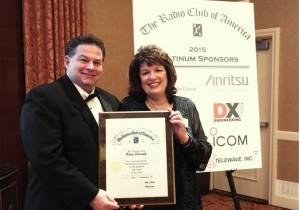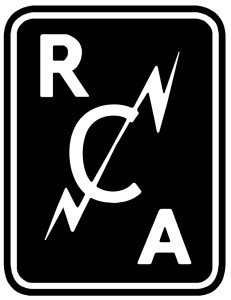You may have heard that I recently had the honor of being recognized as a Fellow of the Radio Club of America.
Attending the awards banquet was really a fantastic experience. It was also a humbling experience – seeing all the incredible people that received awards that night along with gaining additional perspective on the superb achievements of all the club members over the long history of that organization.
RCA Yesterday, Today and Tomorrow
 The Radio Club of America, founded in 1909, is the world’s oldest radio communication club. It promotes cooperation among those interested in the advancement and scientific study of radio communication. It works hard to both honor the past and create the future.
The Radio Club of America, founded in 1909, is the world’s oldest radio communication club. It promotes cooperation among those interested in the advancement and scientific study of radio communication. It works hard to both honor the past and create the future.
Interestingly enough, it’s original name, changed in 1911, was the Junior Wireless Club Limited. It was founded by a group of boys in New York. One of their earlier achievements was convincing the U.S. Congress in 1910 to kill a bill that prohibited amateur experimenting on the airwaves. Now that’s a group of youngsters who had an outsize impact on amateur radio! The RCA went on to kill a similar Congressional bill in 1912. Quite possibly securing the future of our hobby.
Perhaps the signal achievement (pun intended) in early club history was in 1921 when club members combined to build a transmitting station at Greenwich, CT, with 990 watts and an extensive wire antenna designed to work across the Atlantic on 230 meters (1315 kHz). They ended up working every state in the union, Scotland, England, Germany, and Holland. This was a first for an amateur radio station.
Throughout the club’s history, the listing of award winners is simply staggering and truly represents those whose impact on technology has been huge. You can find the full listing at Radio Club of America Awards.
In the present, what I truly appreciate is their focus on scholarship programs and youth activities. In the nearby photo is my good friend Carole Perry, WB2MGP, who is an RCA Director and chairman of their Youth Activities Program. RCA truly preserves the past and eagerly pursues and supports the future.
RCA 2015 Keynote Presentation
 I found that evening’s keynote presentation by Dave Leeson, W6NL, about the role of amateur radio, including the Stanford University amateur radio club, in the development of the West Coast electronics industry and Silicon Valley to be particularly interesting. Its formal title was “Entrepreneurship of Communications in Silicon Valley.”
I found that evening’s keynote presentation by Dave Leeson, W6NL, about the role of amateur radio, including the Stanford University amateur radio club, in the development of the West Coast electronics industry and Silicon Valley to be particularly interesting. Its formal title was “Entrepreneurship of Communications in Silicon Valley.”
Dave is not only a ham radio operator, since 1952, with several DXpeditions, a key role in the Galápagos Islands HC8 contest station, and many other ham radio accomplishments, he’s a Consulting Professor of Electrical Engineering at Stanford University, founded California Microwave, is an IEEE Life Fellow and received the IEEE Cady Award for his work on phase noise. There’s more, but you can see he’s well qualified to speak on technology and the history of radio communications.
Dave agreed to provide some highlights from his presentation. I thought you’d enjoy them.
West Coast Vacuum Tube Innovation
In 1919 the other RCA (Radio Corporation of America) had a monopoly on electron vacuum tubes in the USA. This led to increased prices and restricted distribution. Led by radio amateurs, the West Coast responded with new approaches and new products.
Here are some prominent names from the vacuum tube world of the 1920s and 1930s:
- Fred Terman, 6AE/W6DI [Known as the Father of Silicon Valley].
- Herbert Hoover, Jr., 6SR/6XH/W6ZH, a pioneer in airline safety.
- Ralph Heintz, 6AUQ/W6RH, developed the Gammatron gridless tube in 1926 that avoided patent infringement.
- Charles Litton, 6AO [Invented the modern vacuum pump and glass lathe that enabled volume production of electron tubes].
- Bill Eitel, 6UF/W6UF, and Bill McCullough, 6CHE/W6CHE [Founded Eimac]
- W. Hansen, 6CSY, and Russell Varian [Invented the klystron, the foundation of microwave radar].
- David Packard, 9DRV, founder of Hewlett-Packard Co.
The first venture electronics company in “the valley” was Federal Electric, founded by Stanford graduate and radio hobbyist Cy Elwell in 1909. Elwell is said to have been young Fred Terman’s “Elmer” when Terman and Hoover, Jr. were boyhood experimenters at Stanford.
Terman’s Stanford classmate Ralph Heintz founded Heintz and Kaufman to fill the San Francisco shipping industry’s need for radio sets. Heintz employed Eitel and McCullough and, when his shipping company owners would not risk an RCA lawsuit to sell tubes to hams, the two left to found Eimac. Based on its reputation among the radio amateurs who were radar engineers, Eimac went on to provide two million tubes in WWII.
After graduating from Stanford, Litton became the chief tube engineer at Federal in the late 1920’s, leaving to found his own company after Federal was acquired by ITT in the Depression. Litton was a generous mentor to Eitel, McCullough, and Packard, and helped Terman establish Stanford as a vacuum tube research center. There, Hansen and Varian invented the klystron, the microwave tube that was the basis of microwave radar and communications.
Terman went on to teach at Stanford, founding the university radio club, W6YX, and writing his famous Radio Engineering Handbook. His students included Hewlett and Packard. Terman actually brought this dynamic duo together and suggested they start a business. They are generally credited with launching the modern Silicon Valley. Packard has stated that he learned more from the Stanford amateur radio club than from his classes!
Terman, Hansen, and Varian spent WWII on the East Coast doing radar work, and then returned to Stanford, where Terman became Dean of Engineering and Provost. Hansen invented the electron linear accelerator, and those two helped Varian found Varian Associates, another early Silicon Valley mainstay.
Leeson emphasized that Silicon Valley isn’t just a modern phenomenon, but goes back over 100 years. The companies that got things started were founded and run by radio amateurs, as was engineering at Stanford. Terman connected the two worlds. The culture of the area developed out of the cooperative attitudes among the radio amateurs, who showed that technology ventures could reward entrepreneurs and investors long before the advent of semiconductors, personal computers, the Internet, smartphones and social media.
Hams and Silicon Valley
For those of us familiar with the history of radio and electronics, those are some pretty stellar names, all from Stanford University. But that history doesn’t stop in the 1940s. It continues to this day. Here’s a short list of hams among the many associated with Silicon Valley and a quick review of their achievements:
- G. Villard, Jr., W6QYT. Introduced SSB to amateur radio in 1947, invented over-the-horizon radar based on studies of meteor- and back-scatter.
- Nolan Bushnell, W7DUK. Computer game pioneer founded Atari and created Pong.
- Steve Wozniak, WA6BND. Apple Computer co-founder, designed the Apple I and II.
- David Boggs, AB4XW. Co-invented Ethernet and developed early prototypes of Internet protocols, file servers, and gateways.
- Phil Karn, KA9Q. Developed TCP/IP and forward error correction (FEC) including applying it to amateur satellites.
- E. Moerner, WN6I. Awarded the Nobel Prize in Chemistry in 2014 for his optical study of single molecules.
RCA Award Winners
As you can tell the keynote presentation was stunning and there was so much more than I can include here. But it was also a wonderful experience to see some of my amateur radio colleagues receive awards for their continued service to amateur radio.
Carole Perry, WB2MGP, received the Vivian A. Carr Award in recognition of her substantial contribution in wireless communication.
Tim Duffy, K3LR, received the 2015 President’s Award for his unselfish dedication in supporting the Radio Club of America.
Frank Drake, PhD, received the Lifetime Achievement Award for his fifty years of research and development of radio telescopes and their use in the Search of Extraterrestrial Intelligence (SETI). Icom provided live streaming video of his presentation “Breakthrough Listen and SETI” during the Technical Symposium.
You can see the full list of award winners and 2015 fellows at Radio Club of America 2015 Award Winners.
What a Night
As you can tell it was an incredible night and honor. I’m delighted that I could share just a little bit of that experience with you in this blog post.
73,
Ray Novak, N9JA
Senior Sales Manager
Lifetime Amateur Radio Enthusiast
For further background, you can find the RCA Fellow press release at http://www.icomamerica.com/en/media_events/news/NewsArticle.aspx?id=201426

